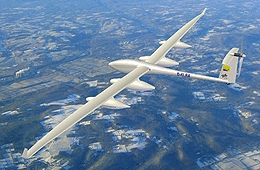According to the centre, the Antares H3 will set range and endurance benchmarks beyond those accomplished by its predecessor, the Antares DLR-H2, which was the world’s first piloted aircraft capable of performing a complete flight powered by fuel cells alone.
The German Aerospace Centre began the project with Lange Aviation this month and the first flight is scheduled to take place next year.

Technically, the new aircraft is based upon the Antares 20E as well as the fuel-cell powered Antares DLR-H2. The Lange Aviation Antares 20E is a self-launching motorised glider with battery-powered electrical propulsion, which has been in series production since 2004.
The fuel cells, which replace the batteries, use hydrogen as fuel. The hydrogen is transformed into electrical energy in a direct and non-combustive electrochemical reaction with oxygen taken from the surrounding air. The only reaction product is water. The aircraft flies carbon dioxide neutral, if the hydrogen is created using energy from a renewable source.
In 2010, the project partners tested how fuel cells perform in aviation using a flying test bed, the Antares DLR-H2. During one of these tests, an altitude record of 2,560m was set.
It is hoped the Antares H3 will demonstrate significantly increased performance - the developers plan to achieve a range of up to 6,000km and endurance of more than 50 hours. For the Antares H2, these values were 700km and five hours respectively.
The aircraft will have a wingspan of 23m, a maximum takeoff weight of 1.25 metric tons and it will carry payloads of up to 200kg. The aircraft will use four external pods to house the fuel cells and fuel.
‘The fuel-cell powered Antares flies carbon dioxide neutral, and emits significantly less noise than other comparable motorised gliders,’ said Dr Josef Kallo, head of electrochemical systems at DLR’s Institute of Technical Thermodynamics. ’It represents a new milestone in the area of efficient, emission-free energy transformation.’
The DLR, which is located in Stuttgart, will assemble the modular fuel-cell system and perform the technical evaluation. Lange Research Aircraft is responsible for the overall integration and for operating the aircraft. The project is being supported by the German Federal Ministry of Transport, Building and Urban Development in the framework of a national innovation programme for hydrogen and fuel-cell technology.
’The efficiency, dynamics and endurance of Antares sets new benchmarks in the area of aviation systems. This opens up completely new applications,’ explained Axel Lange, chief executive of Lange Research Aircraft.
The optimised flight qualities and the simple handling will allow the Antares to fly both piloted and, at a later point in the development, unmanned. As an unmanned aerial vehicle, the Antares H3 could perform numerous tasks such as Earth observation and surveying.
Dr Kallo said the German Aerospace Centre will continue to expand its partnership with Lange Research Aircraft over the next three years.





Glasgow trial explores AR cues for autonomous road safety
They've ploughed into a few vulnerable road users in the past. Making that less likely will make it spectacularly easy to stop the traffic for...